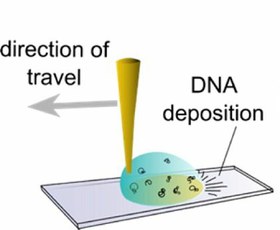Feb 28 2015
Researchers have long sought an efficient way to untangle DNA in order to study its structure – neatly unraveled and straightened out – under a microscope. Now, chemists and engineers at KU Leuven, in Belgium, have devised a strikingly simple and effective solution: they inject genetic material into a droplet of water and use a pipet tip to drag it over a glass plate covered with a sticky polymer. The droplet rolls like a ball over the plate, sticking the DNA to the plate surface. The unraveled DNA can then be studied under a microscope. The researchers described the technique in the journal ACS Nano.

There are two ways to decode DNA: DNA sequencing and DNA mapping. In DNA sequencing, short strings of DNA are studied to determine the exact order of nucleotides – the bases A, C, G and T – within a DNA molecule. The method allows for highly-detailed genetic analysis, but is time- and resource-intensive.
For applications that call for less detailed analysis, such as determining if a given fragment of DNA belongs to a virus or a bacteria, scientists opt for DNA mapping. This method uses the longest possible DNA fragments to map the DNA’s ‘big picture’ structure.
DNA mapping can be used together with fluorescence microscopy to quickly identify DNA’s basic characteristics.
Fluorocoding
In this study, researchers describe an improved version of a DNA mapping technique they previously developed called fluorocoding, explains chemist Jochem Deen: “In fluorocoding, the DNA is marked with a coloured dye to make it visible under a fluorescence microscope. It is then inserted into a droplet of water together with a small amount of acid and placed on a glass plate. The DNA-infused water droplet evaporates, leaving behind the outstretched DNA pattern.”
“But this deposition technique is complicated and does not always produce the long, straightened pieces of DNA that are ideal for DNA mapping,” he continues. It took a multidisciplinary team of chemists and engineers specialised in how liquids behave to figure out how to optimise the technique.
“Our improved technique combines two factors: the natural internal flow dynamics of a water droplet and a polymer called Zeonex that binds particularly well to DNA,” explains engineer Wouters Sempels.
The ‘rolling droplet’ technique is simple, low-cost and effective: “We used a glass platelet covered with a layer of the polymer Zeonex. Instead of letting the DNA-injected water droplet dry on the plate, we used a pipet tip to drag it across the plate. The droplet rolls like a ball over the plate, sticking the DNA to the plate’s surface. The strings of DNA ‘captured’ on the plate in this way are longer and straighter,” explains Wouters Sempels.
To test the technique’s effectiveness, the researchers applied it to the DNA of a virus whose exact length was already known. The length of the DNA captured using the rolling droplet technique matched the known length of the virus’ DNA.
The rolling droplet technique could be easily applied in a clinical setting to quickly identify DNA features, say the researchers. “Our technique requires very little start-up materials and can be carried out quickly. It could be very effective in determining whether a patient is infected with a specific type of virus, for example. In this study, we focused on viral DNA, but the technique can just as easily be used with human or bacterial DNA,” says Wouters Sempels.
The technique could eventually also be helpful in cancer research and diagnosis. “After further refining this technique, we could be able to quickly tell the difference between healthy cells and cancer cells,” says Wouters Sempels.